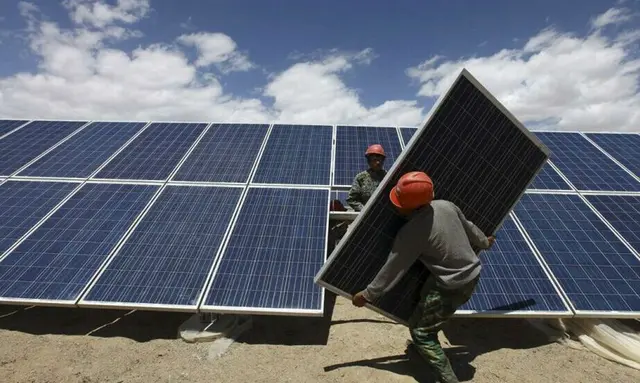China Minsheng New Energy Investment, the solar and wind power unit of Shanghai-based private equity firm China Minsheng Investment, aims to boost its solar farms’ installed capacity more than sevenfold this year despite grid capacity bottlenecks that have limited generation growth in some regions.
The 18-month-old company, which competes with more established rivals backed by state-owned power generation majors for projects, also has an aggressive, five-year, 96 billion yuan (HK$114.2 billion) plan to potentially grab an 8 per cent share of the market by 2020.
Although primarily funded by its parent’s shareholders – China Minsheng Investment is backed by 59 private enterprises – CM New Energy would consider taking investment from other investors and had a long-term plan for an initial public offering, its president, Han Qinghao, said in Hong Kong on Thursday.
“We do not rule out going public in Hong Kong or mainland China,” he said. “We have hired professionals to help us make preparations, including EY as our adviser.
“We have come to Hong Kong to have exchanges with the investment banking community and hope to get some advice on improving corporate governance.”
Han was general manager of CGN Solar Energy Development, a unit of China’s largest nuclear power projects developer China General Nuclear Power, before joining CM New Energy.
The company aims to raise its solar farms’ installed capacity from 0.4 gigawatts (GW) at the end of last year to 3GW by the end of this year, and further quadruple it to 12GW by the end of 2020, or 8 per cent of Beijing’s target for the mainland of 150GW.
Han said CM New Energy also planned to build wind farms, but did not have a clear capacity target.
Its website shows an even bigger goal of 20GW of solar farms in five years – 4GW to 5GW in Ningxia, Xinjiang and Shaanxi, 3GW in southeast China and 5GW overseas – that would cost 200 billion yuan, but Han said that was “old information” that had been adjusted due to changing market conditions.
The installed capacity China’s solar farms, the world’s largest, grew 54 per cent last year to 43.2GW from 28GW in 2014. In the first quarter of this year, capacity rose a further 7.1GW.
Due to a marked slowdown in energy-intensive industries’ growth and their power demand last year, as well as a rapid surge in renewable energy supply in renewable-energy-rich but remote and sparsely populated northern regions, bottlenecks in the power grid worsened.
In the first quarter of this year, the power wastage rate – output generated but not transmitted by the grid – soared to 52 per cent in Xinjiang, 39 per cent in Gansu and 20 per cent in Ningxia. The national average was 13.9 per cent.
Han said he was not too concerned about completing CM New Energy’s 2GW project in Ningxia, given it was a five-year goal, and a high-voltage power grid to be completed next year linking Ningxia and Zhejiang in the southeast would help relieve the bottleneck.
Asked how the young company could finance 96 billion yuan of projects in five years, he said its strong shareholder backing meant it could obtain bank loans at similarly low interest rates as state-owned firms.
Solar projects were typically 70 per cent funded by bank loans and 30 per cent by equity capital, he said, adding CM New Energy had a registered capital of 8 billion yuan, which could fund 24 billion yuan of projects.
It obtained approvals last year to complete 1.4GW of projects – 0.55 GW in Ningxia – that are expected to be completed by the end of June, the deadline for subsidised solar power tariffs to be cut. Some 0.4GW were installed by the end of last year.
It expects to obtain approval for and complete an additional 1.6GW of new projects this year.
(SOUTH CHINA MORNING POST)
 简体中文
简体中文

